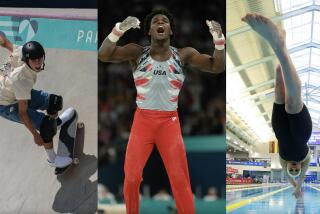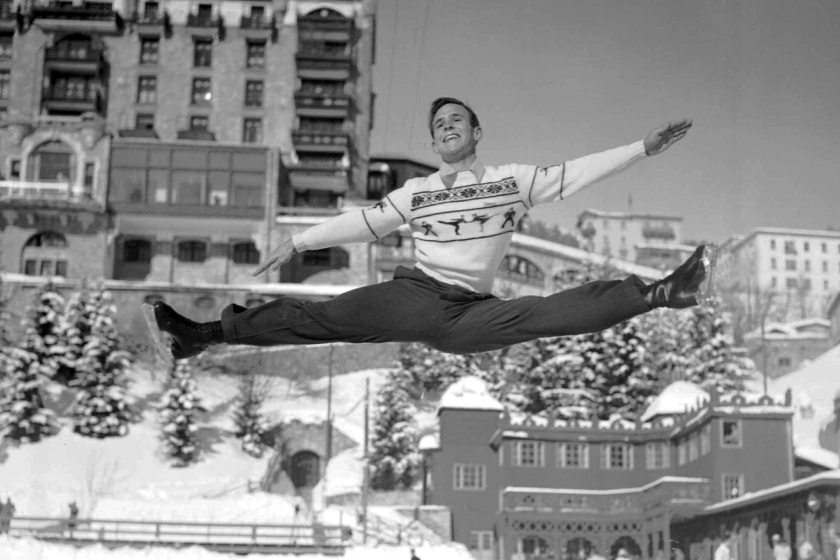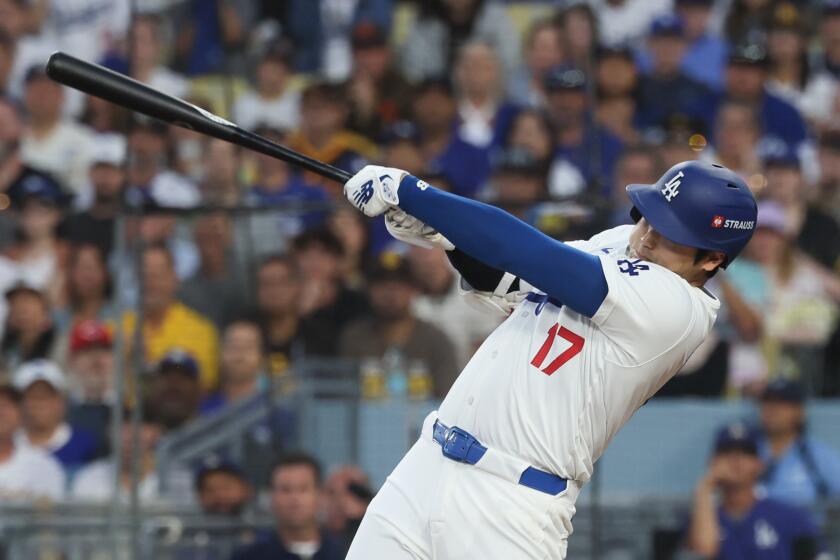Armstrong Remains Head Strong
- Share via
In the summer of 1996, professional road race cyclist Lance Armstrong, then 24, was a strong contender for the Tour de France and for events in the Olympics. As lead rider of Team Motorola, he had raced a tremendous early season, posting breakthrough victories on the European circuit, had won the Tour DuPont and had battled his way to fifth in international rankings.
He was an aggressive young athlete in top form. But inside that mass of muscle and superb conditioning, a deadly foe lay waiting to bring him down.
Six stages into the Tour de France, in miserable weather, Armstrong stopped his bike, tore off his number and officially dropped out of the race. He was fighting a bad cold and throat infection.
Several weeks later at the Olympics, Armstrong placed 12th in the road race and sixth in the time trial, good finishes against the best professional riders in the world, but short of his own expectations. Frankie Andreu, Armstrong’s longtime friend and support rider, reluctantly left his leader behind in the 15th lap to finish fourth himself.
“I asked Lance if he wanted to try and bridge to the [breakaway] group with my help, but Lance said he didn’t feel that great,” Andreu said recently.
Today, Team Motorola is gone, its riders scattered to other teams; Tour DuPont is defunct, and Armstrong, who launched his 1998 racing season Sunday at the Ruta del Sol in Spain with his new team U.S. Postal Service, is neither gone nor defunct. By all laws of nature, he very well might have been.
When he returned to his home in Austin, Texas, in the fall of 1996 to recover from the racing season, after rallying for a strong finish in late-summer European races and signing a multimillion dollar, two-year contract with the French team Cofidis, Armstrong’s body demanded attention. He had been aware for some time that he had one enlarged testicle. He assumed that it was normal. When he started coughing up big chunks of blood, Armstrong saw a doctor. Testicular cancer was found.
The diagnosis was made on October 2, 1996. The next day he was in surgery. A few days later he and his agent, Bill Stapleton, made the situation public. The young man with the bulletproof body was fighting for his life. The cancer had spread from the site of origin to his abdomen and lungs, where the tumor tissue was eroding blood vessels. Additional testing revealed that the restless cancer had established itself as lesions in his brain.
With the same fervor he poured into winning bicycle races, Armstrong found the foremost experts on the disease and plunged into treatment. In all, doctors performed two surgeries, including opening his skull in two places, and hit him with three rounds of the heaviest chemotherapy they could throw at him. By the end of the treatment three months later, he was hairless and gaunt. A year after the original diagnosis, in October 1997, the doctors told him to make plans to get old.
“If he had not seen a doctor, he would have died in several months,” said Dr. Craig Nichols, Armstrong’s oncologist at Indiana University School of Medicine.
It was clear, he said, the cancer had been there for months.
In the early stages, he said, the cure rate is 100%.
The only ones who have a significant chance of dying, he said, are those who arrive at the doctor’s doorstep in Armstrong’s condition.
He thought Armstrong might have a 50/50 chance.
Armstrong informed Nichols that he had no intention of dying.
“He was very aggressive about it,” Nichols said.
“That wasn’t an option he had listed for himself.”Armstrong made a plan and attacked.
“It was almost like taking on a science project,” said Linda Walling, his mother. “We read everything we could get our hands on.”
The key is to ask the right questions.
“It amazes me how many patients have no idea what’s being done to them, or what their options are,” Armstrong said. “I knew everything about my treatment. I knew everything about my options, about the doctors, the dosages, the other medications to offset the side-effects of the chemotherapy. From Day 1 I didn’t know anything, but every day I learned more and more.”
Armstrong drew strength from his friends, who came to visit at his home on Lake Austin.
“He wanted to keep people and friends around him,” Walling said. “That was the beauty of it. Lance welcomed people, anyone who wanted to stay. He would say, Mom, get the calendar out. It was like our community calendar. Every single week was booked.”
His corporate sponsors came to visit.
“They stuck with him,” Walling said. “They made it a point to take time out of their schedules to spend a weekend with Lance.”
When he first gained success on the international racing circuit, Armstrong established, and still sponsors, the Lance Armstrong Junior Olympic Racing Series. It was his way of giving back to the sport.
Armstrong responded similarly to his new situation. He established the Lance Armstrong Foundation for cancer education and research.
The foundation sponsors an oncology conference, a celebrity golf tournament and a road race--the Ride for the Roses--held in May in Austin.
Armstrong met his future wife, Kristin Richard, 26, at the inaugural Ride for the Roses last spring.
Richard is Armstrong’s match in the organization department. She had the May wedding all planned by mid-January.
A new sponsor--a manufacturer of training devices--came aboard while Armstrong was still sick. The company wanted to identify with the powerful image that Armstrong exudes even in adversity.
Armstrong signed with the U.S. Postal Service pro cycling team after Cofidis, which had kept him on under a renegotiated deal through 1997, declined to pick up its option for his second year.
The French team officials could not help but be alarmed by his haggard looks when he arrived in Paris for the news conference held to introduce the team in January 1997. Armstrong had just finished his third--and most debilitating--round of chemotherapy. It had been rough.
“It was a new team,” he said, “I didn’t know any of these riders, it was in French. . . . So they see me walk in like death warmed over. I looked like a sick person. I had absolutely no hair, no eyebrows, no eyelashes, white, pale, as white as this shirt. It was bad, black eyes, sunken eyes. . . .”
Later, Armstrong said, “I heard several reports that I had a week to live, that I had two weeks to live, in the European press.”
Cofidis ultimately backed away.
“They were supportive initially and they were saddened initially and they pledged their support at the first news conference there. And about two weeks, three weeks later they started calling wanting to renegotiate,” Armstrong said. “So it didn’t last very long. Throughout the renegotiation, I had to act like things were normal and things had been worked out mutually, but they hadn’t.
“They could have had him for a song and a prayer in ‘98,” Stapleton said. “But it wasn’t worth it to them.
“The whole situation was a very large motivator for him. I said, ‘Lance, they don’t think you can do it again.’
“Lance said, ‘I’m going to show them. The best thing I can hear is 10 European teams don’t think I can do this.’ ”
In January 1998, Armstrong trained in Santa Barbara before joining the 15-man U.S. Postal Service team for three weeks of spring training in mountainous north San Diego County.
Postal Service raced well enough last year, with 30 wins, to secure one of the 16 guaranteed team slots in the 1998 Tour de France. Last year the team had fought for a wild-card slot and became one of only three teams to finish with all nine riders.
Armstrong rode for the team in 1990-91. Subaru was the title sponsor then, but it had the same owner, Thomas Weisel of San Francisco, whose dream it has been to build a successful American professional cycling team.
The general manager is Olympic gold medalist Mark Gorski. Hands-on coach Johnny Weltz, a Motorola alumnus, rides every training mile with the team.
“I’m a lot more comfortable and relaxed here than I thought I would be,” Armstrong said during the training camp. “I’m happy with the way the relationship’s working out and the reaction I’ve seen from the riders and from the staff to me being on the team, because I’m sort of like the new guy.”
The team has put together a potent combination of American and European riders, including Andreu, who rode last year with Cofidis; Tyler Hamilton, George Hincapie and Marty Jemison--all veteran U.S. riders--Jean-Cyril Robin of France, whose specialty is climbing; sprinter Sven Teutenberg of Germany, climber Peter Meinert of Denmark, climber Dariusz Baranowski of Poland, support rider Pascal Derame of France, Juan Llaneras of Spain, three young U.S. riders--Jonathan Vaughters, Christian Vande Velde and Anton Villatoro, and veteran leader Viatcheslav Ekimov, a Russian now living in Spain.
Ekimov, 32, and Armstrong will function as team leaders, a position of strategic importance. They will be deployed to different races based on their strengths.
“I think we can do a great job together,” Ekimov said.
Armstrong might skip the Tour de France in July, concentrating on the spring classics and the later races, including the world championship and World Cup in mid-October. He was tied for 55th place after two stages in the five-day Ruta del Sol, having finished 63rd among 143 riders in the second stage.
“I have no idea,” Armstrong said. “I’m so far in the unknown.”
People return to normal after surviving testicular cancer, Dr. Nichols said, but unlike Armstrong, “Most of us aren’t on the edge of human endurance.” Armstrong has lost muscle mass. The muscle atrophy can be repaired. He is at 170 pounds, a bit lighter than when he was racing before.
“This may not be a bad thing,” Armstrong said.
Doctors know what chemotherapy does to the body in the short run but are less sure about long-term effects.
“It’s hard to tell at this point what having had cancer means. There’s the chemotherapy, the loss of aerobic conditioning, being removed from competition for 16 months,” Armstrong’s coach, Chris Carmichael said. An athlete’s body, he added, reacts to the stress of training and racing. If the body does not have to adapt to that stress, it loses efficiency.
“It loses the ability to deliver oxygen to the muscles for a given workload,” he said. “Can that be retrained? Yes, if you keep applying the training overload to your body.”
Armstrong says that if he cannot succeed at his previous level, he’ll hang up his jersey. He’s giving it one year.
“I want to just return to the sport and to the peloton and to the other professionals just like I left,” he said. “I don’t want anything special.”
“It doesn’t matter if he ever wins another race,” Andreu said. “He’s already won.”
And a prediction from his mother?
“Well, hell, he’s going to kick butt.
More to Read
Go beyond the scoreboard
Get the latest on L.A.'s teams in the daily Sports Report newsletter.
You may occasionally receive promotional content from the Los Angeles Times.






